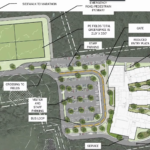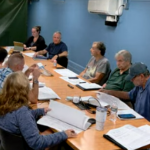Editor’s note: This article originally appeared in the Hopkinton Independent on Feb. 25, 2016.
Most people associate slavery with the Deep South, where the economy until the Civil War relied on enforced labor to pick cotton and tobacco. But slavery was common around New England, too — even in Hopkinton.
While it ended earlier here than it did in the South, slavery was a part of New England’s early history. Emily Blanck’s 2014 book “Tyrannicide: Forging an American Law of Slavery in Revolutionary South Carolina and Massachusetts,” noted that while a 1641 law prohibited Puritans from keeping slaves, it provided exceptions for “strangers” and “war prisoners.” These two loopholes cleared the way for enslaving Africans and Native Americans. The first slaves from Africa arrived in Massachusetts in 1638.
“As Massachusetts Puritans created a thriving commercial and shipping center, their ships began to partake directly in the Atlantic slave trade, bringing more slaves to their shores,” the book notes. By 1764-65, according to census records, Massachusetts had 5,779 slaves, about 2.5 percent of the total population, the book reported.
A 1915 paper by Frances Safford to commemorate Hopkinton’s 200th anniversary, published on the Hopkinton Historical Society website, observed that slavery was accepted here, even by men of the cloth. “Rev. Samuel Barrett was the first minister,” Safford wrote. “His salary was 60 pounds in money and his firewood. Mr. Barrett’s home stood on the site of the present Town Hall, and as he lived at a time when the colored people were held as slaves, he had a number of servants.”
Linda Connelly of the Hopkinton Historical Society did extensive research on slavery in Hopkinton, and her project was presented at a discussion in 2015. She found a treasure trove of information in the works of Hopkinton historian Elias Nason, who in the mid-1800s began researching the topic of slavery.
Nason wrote that Barrett “received Jackee, a negro” and other slaves, and pointed out that “Brampton Sketches,” an 1890 novel written by Hopkinton resident Mary Claflin and based on her hometown, describes a high gallery where the “colored people sat,” what she described as relics of the slave trade. And a 1906 paper written by Appleton H. Fitch notes that Barrett “spoke with regret at being compelled by circumstances to dispose of [his slaves].”
According to Nason, about 15 slaves older than age 16 lived in Hopkinton in 1765.
Another slave owner was Charles Henry Frankland (the famous Sir Harry Frankland), an English gentleman who moved to Boston in 1739 and worked as a merchant trader. Frankland notoriously consorted with a lowborn teenager, Agnes Surriage (and later married her), but not before he scandalized all of proper Boston society. He built a country home in Hopkinton to get away from the gossip.
James Ward’s 2014 book “The Common Uncommon” notes that, “The terraces leading up from Frankland Road were constructed by his slaves.” After Frankland’s death in 1768, his widow lived in the home for a while. Eventually her sister Mary Swain lived there, along with “three negro slaves, of which one is old and blind,” Ward’s research found.
And from Osbornes’ History of Hopkinton, Connelly found that, “A slave was responsible for burning the Frankland estate; a child hunting for a silver spoon and a barrel of something caught fire.”
According to Nason, a Frankland slave named Robert was described as being a “genuine son of Africa” with the letter ‘C’ imprinted on either side of his body and having “skin as black as ink.” Another Frankland slave named Dinah gave birth to several mixed-race children on the Frankland estate. One was famous magician and performer Richard Potter, the first American-born magician, whose father allegedly was Sir Harry’s son. Dinah’s other children — Phebe, Sidney and Robert — “were described as mulattos and very bright,” according to Nason.
Nason’s other notes mention “Scipio,” who worked in the meeting house, “Tobias’ wife,” described as “a negro,” and “Tilda,” who belonged to Agnes Surriage’s sister Mary.
After slavery was outlawed in Massachusetts in the late 1700s, some former slaves appeared to stay with their Hopkinton families. The 1790 census, (also referred to by Nason) included categories for “Head of Household,” “Free White females,” “Free white Males Under 16” and “Free White Males Above 16,” and then a separate category called “All Other Free persons,” the implication being former slaves.
“They very likely are house servants; perhaps in some instances farm laborers,” noted Connelly in her paper. “We can only imagine what life was like for them. Treated like family member? Treated like someone from a much lower class? How well were they paid? Certainly they were not treated as equals — subservient, perhaps viewed in an affectionate but subservient relationship?”
Connelly found something else more troubling: several mentions of mixed-race children being born to servant women. “I would have to assume that … the children were fathered by white men and that the individuals took advantage of black women’s lowly status and lack of power; a gentle way of saying that they probably were raped,” her report notes.
Hopkinton Vital Records to 1850 mention “Sarah, Daughter of Tobias, a servant of Mr. Charles Morris of Boston and Sarah, a free woman” interpreted as: a black baby born in Hopkinton to a father who is a black servant and a black mother who is free.
Other mentions in the Hopkinton records include Jane, “a servant of the late captain Thomas Clarke, and George Gyres, a free negro of Grafton,” who filed intentions to marry in April 1777; Zilpah, “A Mollatto Young Woman, a Servant, baptised Sep 27, 1769”; and John Laton, “black, died of Consumption Sep 26, 1810, age 58.”
And Fitch’s 1906 paper noted that he once possessed a bill from a Hopkinton resident for days of work done by one of his slaves at the gristmill dam, in what is now Ashland. Fitch also wrote that he knew the daughter of one of the slaves, who lived to be over 100 years old.
Thanks to Connolly’s research of these records, a picture of slavery in Hopkinton has emerged.
“I was able to piece together many small pieces of info to come up with a list of names of individuals who certainly were slaves, or slaves and their children who later became “servants for life,” she concluded.
“I find it amazing to understand that in this town, Hopkinton, where my children grew up and went to school, slaves lived, labored and were owned by individuals,” she added.
For a related story on Edwards Hopkins, the man for whom the town was named, and his history as a slaveowner, click here.






















0 Comments